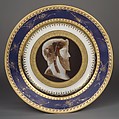Plate with imaginary portrait of the tragic poet Moschion
Manufactory Sèvres Manufactory French
Decorator Jean-Marie DeGault
The decorators at Sèvres painted cameos in a way that convincingly captures the stones' translucency. This plate was one of seventy-two in the service iconographique grec. One set went to Napoleon's uncle Cardinal Fesch, another to a member of Pope Pius VII's entourage.
Images of cameos proliferated on objects of all sorts during the age of Neoclassicism. Some were copies, some inventions, but all owed their origins to Greco-Roman antiquity. By implication, these adaptations underscored the owner's erudition and sober good taste. The owner might be rich or humble. Pottery such as Wedgwood's, for example, made enough use of cameos to satisfy all comers.
Due to rights restrictions, this image cannot be enlarged, viewed at full screen, or downloaded.

